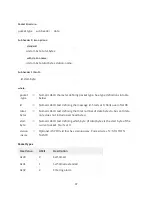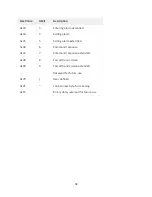
31
The standard decimal format is human readable while binary formats require some processing
before the values can be read. The standard decimal format is generally twice as long as the
binary transmission. This means that less data can be sent in the same amount of time using the
standard decimal format.
An example of a standard decimal format message is shown below. This message comes from a
station with three sensors in the self-timed group. The sensors have been named HG, PC and
TA. The battery voltage is the voltage of the battery just prior to transmission.
: H G 0 # 1 5 1 0 . 2 0 1 0 . 1 5 : P C 0 # 1 5 5 0 4 9 : T A 0 # 1 5 - 2 2 . 1 - 2 2 . 0 : V B 0 1 2 . 2
Battery
Temperature
Precip
Gauge Height
Offset Time
Data Interval
Newest gauge reading
Older gauge reading (by data interval time)
The names HG, PC, TA and VB used in the transmission are called SHEF Physical Element
codes (PE codes) and are the names given to the outputs in the 8310. Be sure to change the
output names if you want specific codes sent in the transmission. NESDIS has a recommended
list of SHEF PE codes on its website at
http://noaasis.noaa.gov/DCS/htmfiles/schefcodes.html
“SHEF Fixed” is a special version of the SHEF format where numbers are fixed to seven decimal
points.
SSP Format
“SSP” is a binary format following the specifications of the Sutron Standard Protocol, which is
useful when transmitting to XConnect or Tempest master stations.
If you are interested in knowing more about the low-level details of the protocol, please contact
Sutron Customer Service.
Text Format
The Text format is an ASCII, human readable format intended to convey the current status of the
sensors, quality, and alarm state. It is similar in format to the “SHOW” command, and is
particularly useful for alarm messages. Sensor readings are separated by <CRLF>, while fields in
the sensor data are separated with a space.
An example of a Text format message:
RTU01 12:22<cr><lf>
STAGE 4.55 G H+R+<cr><lf>
RAIN 2.0 G OK<cr><lf>
The message begins with the station’s name (“RTU01”) and the current time in HH:MM (12:22)
format followed by a list of sensor readings containing the name of the sensor (“STAGE”), the
value (“4.55”), the quality (“G”), and the alarm status (“H+R+”).





































